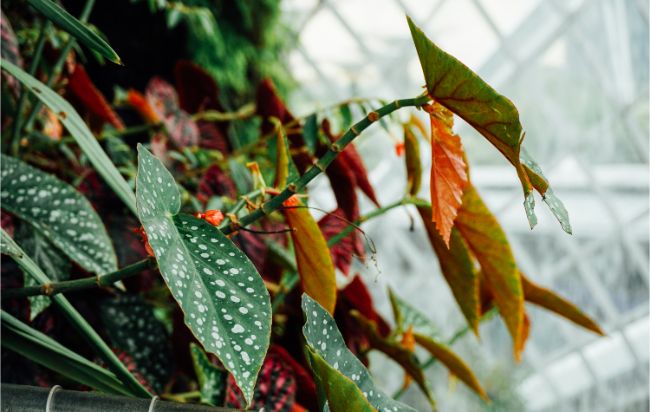Begonia maculata, or Polka Dot begonia as it’s often called, is a splashy show-stopper that looks fantastic with it’s olive green leaves and contrasting spots. It’s a houseplant that is likely to turn heads in your home, and thankfully it isn’t too difficult to care for. Let’s get started with a quick summary of begonia maculata care.
How to care for Begonia maculata: Begonia maculata needs bright indirect light, well-aerated soil that dries a bit between waterings, fertilization every 2-4 weeks, and temperatures of 65°F (18°C) to 86°F (30°C). They are fussy about humidity and need semi-regular pruning, but they’re very easy to propagate.
In this article, we’ll share how to keep a Begonia maculata happy, and how to fix problems that can arise. We’ll include tips to keep them looking their best, so you can amaze your guests with a plant they won’t forget.
Overview Of The Begonia Maculata
The head-turning Begonia maculata is trending now, but it’s been around for a while. This angel winged cane begonia is also called a Wightii, Clown, Spotted, or Polka Dot begonia.
The plant’s exotic look has many moving parts: silver polka dots that seem painted on olive-colored leaves, crimson-colored undersides, and sprays of open bell-like red or white flowers with bright yellow centers on bamboo-looking knotty stems. If you’re looking for something unusual that attracts attention, this over-the-top begonia is a great choice.
It’s called “easy” and can be—but it needs pretty specific conditions in the way of humidity, light, and watering. Once you get it dialed in, however, you’ll have a plant that’s the envy of your neighborhood.
Begonia Maculata Care
- Scientific Name: Begonia maculata
- Common Name: Polka Dot Begonia, Spotted Begonia, Trout Begonia
- Light Requirements: Bright, indirect light. Higher light levels will promote strong growth and blooms, but avoid direct sunlight.
- Watering: Keep the soil generally moist, letting the top half inch of soil dry out between watering. Will not tolerate soggy soil.
- Soil: A light houseplant potting mix is ideal. Add perlite if drainage is insufficient.
- Temperature: 65°F (18°C) and 86°F (30°C).
- Fertilizer: Balanced, water-soluble fertilizer applied every 2-4 weeks when the plant is actively growing. I use this one.
- Humidity: High humidity is important. >45% ideally. A digital hygrometer can be useful to monitor humidity.
- Flowering: Bloom from spring to fall, producing clusters of white flowers with cheery yellow centers on a single stem.
- Pruning: Prune back at least twice per year to maintain compact growth.
- Propagation: Stem cuttings are easily propagated in soil or water.
- Re-Potting: Annual repotting in spring will help greatly.
- Diseases and Pests: High humidity and overwatering can cause powdery mildew, botrytis, bacterial leaf spot, stem and root rot. Whitefly and mealybugs are sometimes a problem, but easily dealt with.
- Toxicity: Toxic to pets and people if ingested.
- Where To Buy: Buy Begonia maculata online at Etsy. (I buy most of my houseplants from Etsy).
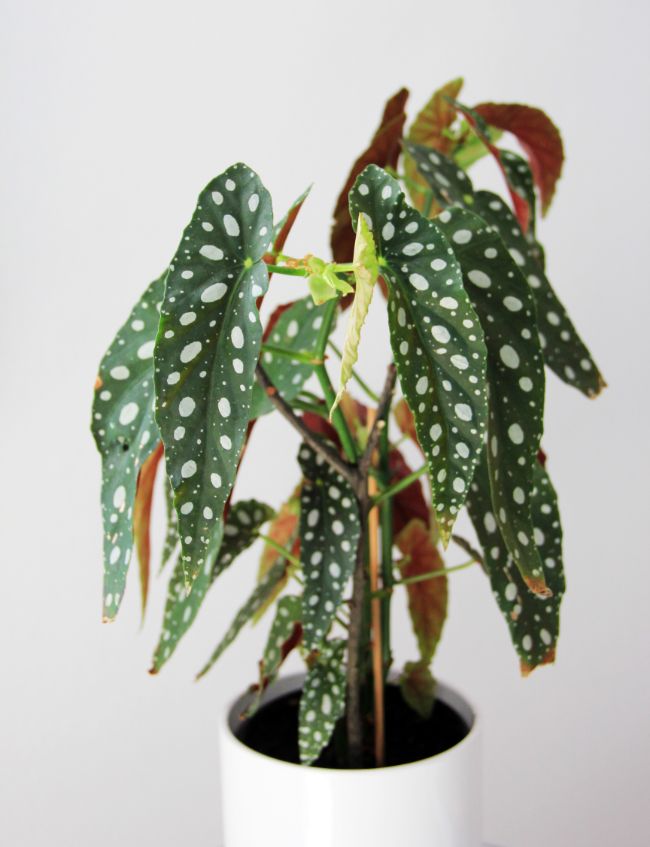
Characteristics Of Begonia Maculata
These evergreen perennials hail from tropical forests of Brazil, so it’s no surprise they need warmth, strong filtered light and consistent moisture. They are a fairly fast grower that can reach three feet or more, and their cascading white flowers bloom throughout the warm season.
As a cane begonia, the plant’s thick stems hold a bit of water and don’t like wet conditions. They appreciate having their topsoil dry out between waterings.
Light is important, too, but the secret to begonia maculata care is the humidity factor. Steamy environs mimic its native habitat. You don’t need to construct a greenhouse for it, but you’ll need to make some humidity allowances to keep your maculata fresh and happy. No one wants a sad clown begonia.
Proper potting is another big factor. There’s a line to walk here: they like being somewhat rootbound but quickly wear out their soil in close quarters. Yearly repotting is the best practice, even if you’re just returning them to the same container.
Maculatas also need judicious pruning and grooming to look their best. One fortunate characteristic of these angelic-winged plants is how easily they propagate. It can be easier to grow a new plant than keep a grown one happy … crazy, right?
Humidity For Begonia Maculata
We’re going to talk about humidity first, because it’s the single element that can spell success or mysteriously mediocre results with this plant. They may not perish in low humidity, but they won’t truly flourish. Unexplained leaf loss and failure to flower can often be remedied by upping the ambient moisture.
Those who have the greatest success keep their maculata’s humidity high, even if they don’t highlight it.
Grouping them with other plants and using water trays are basic methods to raise humidity, but if your home is very dry—and most tend to be—a humidifier is the ultimate solution. It’s more work but will boost the health of all your tropicals, and humidity has positive benefits for humans, too. Read more about other ways to improve humidity for your plants in this article.
Try for at least 45% humidity; higher is better. Paying attention to humidity is extra important in winter, when indoor heating parches the air.
PRO TIP: An inexpensive hygrometer is a wise investment.
Polka Dot Begonia Light Requirements
Give your maculata a bright spot out of strong sunlight: direct rays can fade the silvery spots or even burn the foliage. A southern exposure works well in winter months; east or west windows are fine year-round as long as you keep them out of direct light. Bright filtered light is the goal.
If necessary, the plant will tolerate low light, but it won’t be happy in very dim quarters. Southern gardeners should consider the polka dot begonia a shade plant, but those in colder climes can put them in bright windows with limited direct morning or afternoon sun.
You’ll know your maculata isn’t getting enough light by its leaves: first they lose some color, then turn yellow, and finally start to shed. The leaves will show scorched areas if they’re getting too much.
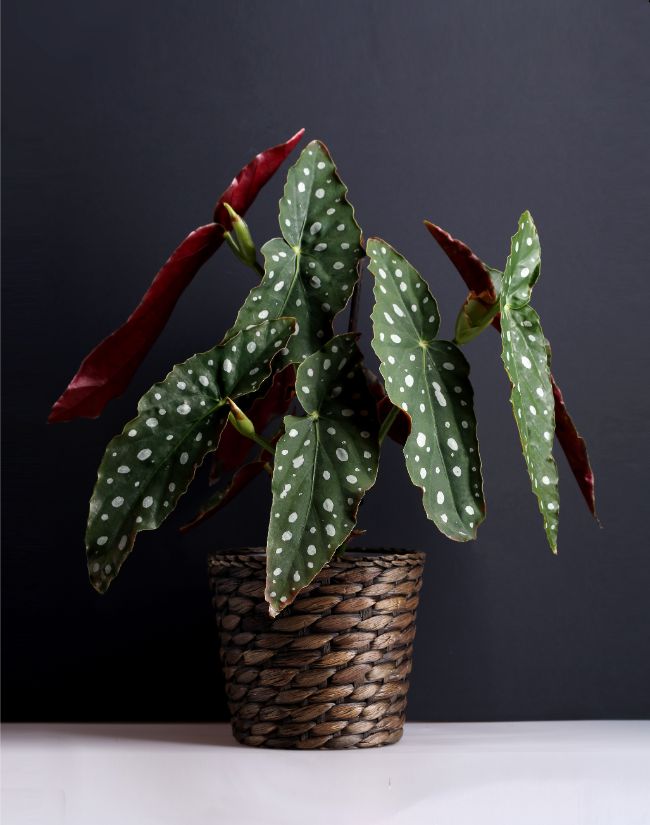
How To Water Begonia Maculata
Watering this begonia can be tricky unless you have the right kind of soil, which we’ll explain shortly, but first let’s go over the rules.
Maculatas like moist soil most of the time – never give them a drought – but they benefit from having the top half-inch of their soil dry out before rewatering. These plants easily develop root rot if they’re kept too wet, so never water when the soil is moist.
Allowing the topsoil to dry also discourages fungus and nuisance pests like gnats. They don’t like getting their leaves wet, so bottom watering is often recommended – but, if that seems a hassle, their leaves are large enough to avoid if you’re careful.
The point is to keep an eye on their soil, and water thoroughly once the top has dried sufficiently. They like a little break between waterings, but actual stress is not good: they should never wilt.
If you’re struggling to know when to water your begonia, or any of your other houseplants, you should read my article about when to water houseplants. This covers some really useful tips to help you avoid overwatering or underwatering your plants.
Choosing Soil For Begonia Maculata
Like many plants, Polka Dot begonia likes well-draining soil that holds moisture without becoming soggy. They do well in light commercial mixes; but, to give them perfect conditions, it’s a good idea to mix in these amendments:
• Perlite – These tiny white balls of fluffy, almost Styrofoam-textured material are actually natural volcanic glass. They do a great job keeping a soil well-aerated and light, and also help insulate the soil from rapid temperature change. NOTE: Don’t confuse perlite with vermiculite, which holds too much moisture.
• Wood chips – A sprinkling of non-toxic wood chips aids aeration: the angular chips create welcome space in the soil. The chips decompose, but it’s not a concern as maculatas are frequently repotted and refreshed.
• A small amount of compost or inorganic fertilizer is a positive addition. Don’t put in as much as the bag recommends; a half-handful a pot is enough. You’ll be lightly fertilizing the plant anyway—this just bolsters fertility.
Start with a light commercial potting soil and add a few handfuls of perlite along with a lesser amount of wood chips until you get a springy, fluffy mix. Consider mixing enough to keep for future seasons. Store it in an airtight container to keep it fresh and sterile.
Temperature Requirements
This one’s easy if you’re keeping them indoors, because they like the same temperatures we do. Keep them out of drafts, and avoid temps of 59°F (15°C) or below.
They do best between 65°F (18°C) and 86°F (30°C) but tolerate warmer temps during the day. They are hardy outdoors for USDA Zone 10. For those in colder climes, don’t wait until first frost to bring them inside, unless you want to free up their pot.
Fertilizing: The Easy Part
Even under high light these plants are moderate feeders, so they’re easy to keep fed. The main thing is to not overdo it: you don’t want brown tips and edges on those fancy leaves.
No special mix is needed, just a balanced fertilizer with equal NPK numbers. Dilute it 50% and feed them every two to four weeks when they’re growing, and cut back during the winter. This is the fertilizer I use for most of my houseplants. It’s easy to use and I’ve had great results year after year.
Flowering
Maculatas bloom from spring to fall, producing clusters of white flowers with cheery yellow centers on a single stem. They’re more a nice accent than a feature.
You don’t usually need to help them bloom: normal fertilization and good light should do the trick.
If you’re seeing fewer blooms than you’d like, try upping the light. Experiment with giving them gentle direct morning or late afternoon sun. Also, being rootbound can put them in the flowering mood.
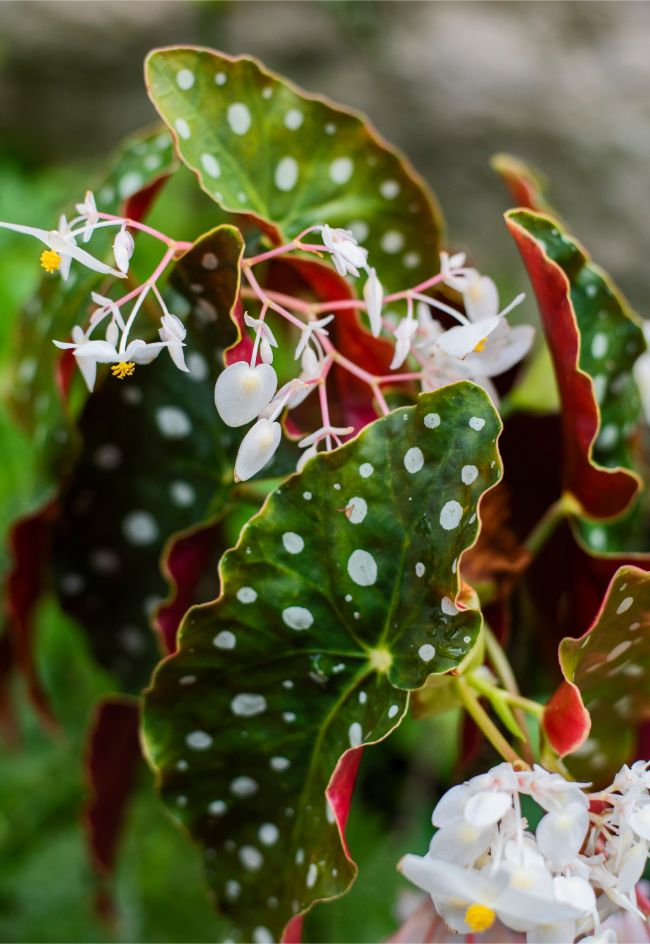
Practical Pruning
A well-filled out maculata is a spectacular plant, but the bushy look takes some intervention. The canes become sparse and leggy, because the plant tends to put more energy into growing up instead of out. Pruning fixes this tendency.
The mildest form of pruning is pinching out the tips. (This term of art means cutting, not just pinching.) The cane tips issue a hormone to suppress branching, so removing them stimulates bushier growth.
Cut a quarter-inch above a leaf. A new leaf will shortly sprout just below the cut. You can do more serious plant remodeling using the same method above any leaf.
NOTE: Use sharp, sterilized shears. Dipping them in isopropyl alcohol works well.
Significant pruning twice a year is typical, but you can do less every few weeks after fresh growth emerges.
Propagating Begonia Maculata Is Easy
The only thing easier than pruning a maculata is propagating it. There are two basic methods: putting them in water or straight into soil.
Water Propagation – Simply place the cutting’s end into a jar of water. Small containers are best: the stem releases rooting hormones you don’t want to dilute.
Soil Propagation – The one-step method is to dip the end of a cutting in powdered root hormone and bury it in potting soil. PRO TIP: A chopstick or pencil works great to poke a hole in the soil for the stem. Firm up the soil around the cutting and water thoroughly.
Regardless of method, once cuttings are in soil, you can help their growth by putting the pot into a plastic enclosure or Ziploc bag … open it every couple of days and mist. Give the cutting good light, keep its temps comfortable, and in a few weeks your new plant will be established!
Repotting And Planting Tips
Yearly repotting is recommended. Maculatas like being a bit rootbound in small pots, but their soil becomes exhausted from its densely packed roots. Even if you’re not potting up, annual soil refreshment does them good.
Because they’re prone to getting top-heavy, select a heavy pot like terracotta or stone. Alternatively place their light pot inside a heavier container.
If you’re replanting in the same sized pot, gently loosen and remove dirt around the edges of the rootball to make room for fresh soil.
Don’t increase pot size too much: you don’t want them spending excess energy on their root system. It’s not their standout feature.
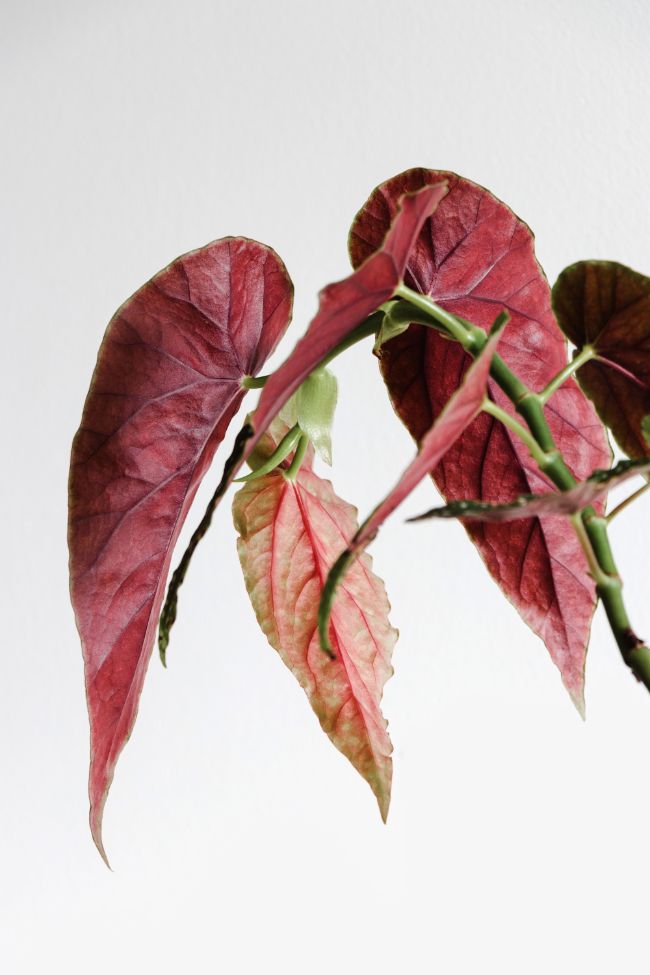
Diseases and Pests: Prevention Is Key
If you keep your Maculata healthy and observe basic plant hygiene—keep their leaves clean, sterilize your tools—it won’t be susceptible to pests or diseases. The main problems are fungus and infestations related to high-moisture.
Powdery Mildew
This fungal disease is one of their most common ailments. Unfortunately, otherwise healthy humid conditions increase this threat. It begins with circular spots of white powdery looking cover on foliage … and spreads.
Remove affected material and treat with a fungicide—but treatments can be ineffective and prevention is best. Always let the topsoil dry before rewatering and maintain good air circulation.
Botrytis
Another fungal disease, botrytis causes soggy, brown splotches. It often starts on lower leaves touching the soil. Poor air circulation can contribute. Remove fallen foliage or blooms, and prune affected areas. Sterilize with methylated spirits and apply fungicide if it returns.
Bacterial Leaf Spot
This disease causes pimple-like leaf spots. You can limit damage by pruning away the affected areas—heavily infected plants should be safely discarded.
Stem Rot
Prevention through well-drained soil and careful watering is the only treatment. The stems affected by the disease become mushy, puffy, and black.
Pythium Root Rot
Another bummer, this disease turns roots yellow and lower stems black. Judicious watering helps prevent it (notice the theme?), as does sterilized soil. Contaminated plants should be thrown away safely—not composted. The disease is very contagious.
Mealybugs And Whiteflies
The trouble with these pests is that pesticides aren’t very effective: you’ll kill beneficial bugs before affecting them. These tiny vampires colonize under leaves and stem joints; whiteflies fly around when disturbed.
Applications of insecticidal soap sprays and oils can help. Another method is using a short-acting organic pesticide before releasing beneficial predators like ladybugs to gobble the rest. Either way, prepare for a siege.
Is Begonia Maculata Toxic?
These angel wing begonias are considered toxic to dogs, cats and horses by the ASPCA. The toxins are primary in the roots, though its stems and leaves can cause oral irritation.
Common Questions
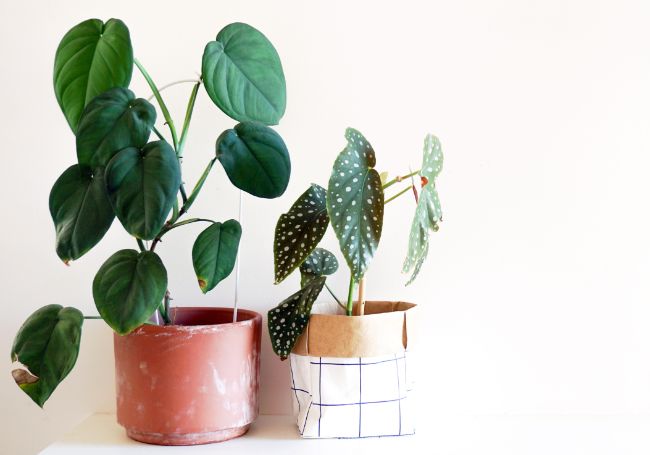
Why Are My Begonia Maculata Leaves Turning Yellow?
Overwatering is the classic cause of yellow leaves, but other factors can contribute. Low light – or too much – are possibilities, as well as chills, disease, infestation, or under-fertilization. Brown spots, edges and leaf tips can be caused by heat, direct sun, or over-fertilization.
Why Is My Begonia Maculata Dropping Leaves?
Maculatas can be temperamental, so run through our care checklist. Most often its humidity is not high enough. The air may be stagnant or polluted. Heavy soil can cause lingering malaise. If all else fails, move it to another bright location.
How Can I Purchase A healthy Begonia Maculata?
First, check the soil: it should be light and airy without excessive bark. A lanky plant can be okay, but the leaves should be healthy and free of damage.
Be careful with small specimens, which may be recent cuttings with minimal roots. Gently lift the plant from its pot to check the root ball.
Begonia Maculata Dying? Suggestions To Rescue Your Plant
The most common issue with “saving” a maculata is optimizing its soil, which is often too heavy or exhausted. Here’s what to do:
- Gently remove the root ball and loosen the dirt.
- Place the roots and soil under a hose or faucet to rinse off clinging soil. Take care not to tear the roots.
- Replant by holding each maculata stem as you fill around it with fresh soil.
- Water thoroughly to settle the soil.
Help, my Begonia maculata is falling over!
As these plants grow taller, they benefit from a little support. Thin stakes and soft ties work best – find a dark color that doesn’t stand out. Repotting time is ideal for staking, but anytime is okay if you’re careful.
Insert the stake so that it’s angled away from the direction the stem leans. Place ties away from leaves and flower stems, which pop off easily if rubbed.

